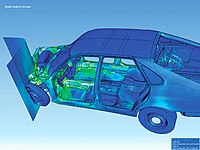
Photo from wikipedia
The mesh stiffness of gear pairs used in aerospace applications, such as geared turbofan, has a vital influence on vibration and noise. To compensate for the deficiencies of the conventional… Click to show full abstract
The mesh stiffness of gear pairs used in aerospace applications, such as geared turbofan, has a vital influence on vibration and noise. To compensate for the deficiencies of the conventional method that does not consider slice coupling and structure coupling simultaneously, a comprehensive mathematical model for computing the mesh stiffness of helical gears is established. In this novel model, the effect of structure coupling and slice coupling between neighboring sliced gears are considered. The effect of the axial component of meshing force is also taken into account simultaneously. The results obtained by the comprehensive model are consistent with the finite element method and it proves that the novel mathematical model is sound. The influences of the helical angle and addendum modification coefficient on mesh stiffness are studied. The results show that the mesh stiffness of helical gears would be decreased in multiteeth regions caused by structure coupling. With or without consideration of the axial component, the relative mean values of mesh stiffness become larger with an increasing helical angle. The fluctuation value of mesh stiffness decreases when a positive addendum modification coefficient is adopted. The addendum modification also changes the phase of mesh stiffness. This study is helpful for a vibration analysis of gear transmission systems.
Journal Title: Applied Sciences
Year Published: 2020
Link to full text (if available)
Share on Social Media: Sign Up to like & get
recommendations!